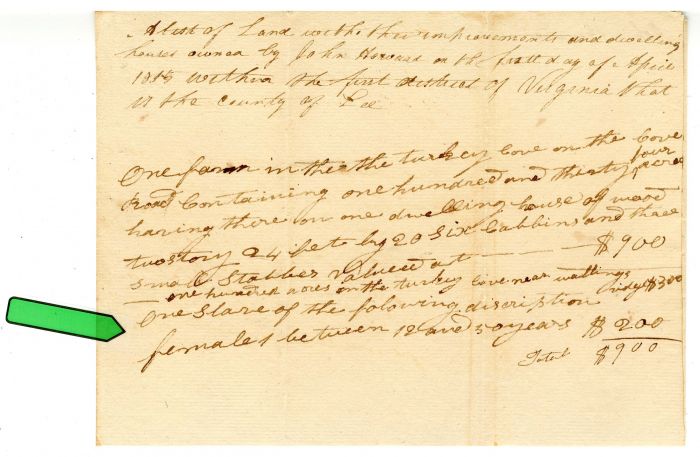1815 dated Slavery Document
Inv# AM1741
1815 dated document regarding female slave between 12 and 30 years.
Slavery in the United States was the legal institution of human chattel slavery, comprising the enslavement primarily of Africans and African Americans, that existed in the United States of America from its founding in 1776 until the passage of the Thirteenth Amendment in 1865. Slavery was established throughout European colonization in the Americas. From 1526, during early colonial days, it was practiced in Britain's colonies, including the Thirteen Colonies which formed the United States. Under the law, an enslaved person was treated as property and could be bought, sold, or given away. Slavery lasted in about half of U.S. states until 1865. As an economic system, slavery was largely replaced by sharecropping and convict leasing.
By the time of the American Revolution (1775–1783), the status of enslaved people had been institutionalized as a racial caste associated with African ancestry. During and immediately following the Revolution, abolitionist laws were passed in most Northern states and a movement developed to abolish slavery. The role of slavery under the U.S. Constitution (1789) was the most contentious issue during its drafting. Although the creators of the Constitution never used the word "slavery", the final document, through the three-fifths clause, gave slave-owners disproportionate political power by augmenting the congressional representation of slaveholding states. All Northern states had abolished slavery in some way by 1805; sometimes, abolition was a gradual process, and hundreds of people were still enslaved in the Northern states as late as the 1840 Census. Some slaveowners, primarily in the Upper South, freed their slaves, and philanthropists and charitable groups bought and freed others. The Atlantic slave trade was outlawed by individual states beginning during the American Revolution. The import-trade was banned by Congress in 1808, although smuggling was common thereafter.
The rapid expansion of the cotton industry in the Deep South after the invention of the cotton gin greatly increased demand for slave labor, and the Southern states continued as slave societies. The United States became ever more polarized over the issue of slavery, split into slave and free states. Driven by labor demands from new cotton plantations in the Deep South, the Upper South sold more than a million slaves who were taken to the Deep South. The total slave population in the South eventually reached four million. As the United States expanded, the Southern states attempted to extend slavery into the new western territories to allow proslavery forces to maintain their power in the country. The new territories acquired by the Louisiana Purchase and the Mexican Cession were the subject of major political crises and compromises. By 1850, the newly rich, cotton-growing South was threatening to secede from the Union, and tensions continued to rise. Slavery was defended in the South as a "positive good", and the largest religious denominations split over the slavery issue into regional organizations of the North and South.
When Abraham Lincoln won the 1860 election on a platform of halting the expansion of slavery, seven slave states broke away to form the Confederacy. Shortly afterward, the Civil War began when Confederate forces attacked the U.S. Army's Fort Sumter in South Carolina. Four additional slave states then joined the confederacy after Lincoln requested arms from them to make a retaliatory strike. Due to Union measures such as the Confiscation Acts and the Emancipation Proclamation in 1863, the war effectively ended chattel slavery in most places. Following the Union victory in May 1865, upon ratification of the Thirteenth Amendment in December 1865, chattel slavery was effectively ended any place subject to the jurisdiction of the United States.










Ebay ID: labarre_galleries